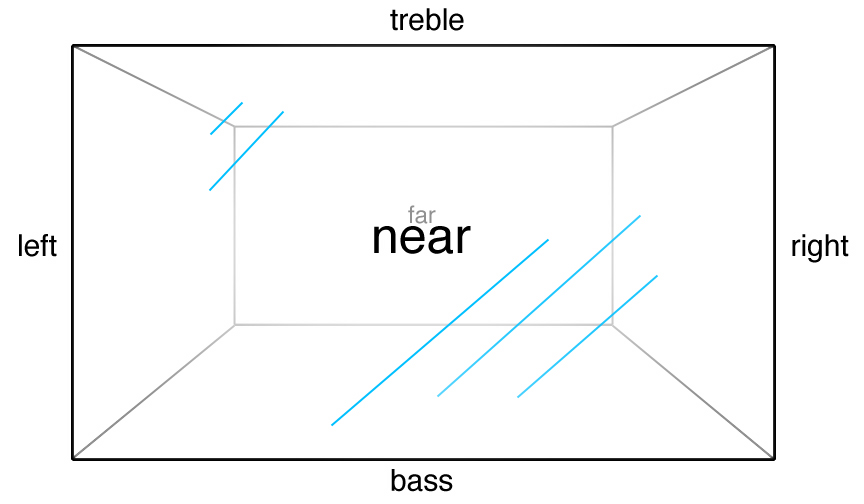Posts Tagged George Martin
Pressed Up Against The Glass: Visualizing And Discussing Sound
Posted by Gavin Bradley in Engineering, Mixing, Production on August 11, 2010
In 1966, during the recording of ‘Tomorrow Never Knows’ for the Beatles’ Revolver album, John Lennon came up with a request phrased in the language of an artist: ‘I want my voice to sound as though I’m a Lama singing from a hilltop in Tibet’.
Producer George Martin had to interpret this request and come up with a concrete plan of action, which he then had to describe in technical terms to the recording engineer, Geoff Emerick, and the other assistants working under him.
Martin’s plan, documented in BBC’s interviews with George Martin on The Record Producers, was to play back the vocal track through a spinning Leslie speaker inside a Hammond organ and record that. I don’t know if the resulting warbly sound was exactly what Lennon had heard in his mind, but he was delighted with the freshness of the effect.
One of the greatest challenges producers face is coming up with the right language in discussions with artists and engineers. We’re all supposed to be sculpting the same thing. Mixing, for example, involves deciding on the placement of each instrument in a song – from its relative volume and clarity to its spatial positioning in the stereo field. Since we all interpret and describe sound differently, how do we take the seed of an idea born in one person’s esoteric imaginings and explain it clearly to a team?
The right metaphor helps.
A friend with musical leanings (and great skills in metaphor) once told me he likes to feel that he can walk into a recording and move around, visiting each instrument at will. He earmarked Steely Dan’s 1977 offering Aja as a good example of a sonically spacious album.
This idea of being able to ‘walk into’ a mix resonated with me, because I’ve always had a similar visualization of sound: I imagine the song is contained in a big glass box immediately in front of me. Sometimes I describe this model to the people I’m working with so we have a language for discussing our mix decisions.
In this box, a sound can be anywhere, left to right, in the stereo spectrum. It can be low or high, like the bass of a kick drum or the treble of a cymbal. It can be far away because it’s quiet and soaked in reverb (that residual echo of a bathroom or church), or it can be near because it’s loud and dry (just the direct sound with no reverb).
Trends in mix aesthetics come and go, and most of them are set in motion by an advance in technology. In the 60s drums were fed through analog compressors that tended to add a pleasing distortion, and big boxy reverbs were thrown on vocals using a huge room called an echo chamber. In the 70s 24-track recording became a reality and elements could be separated and controlled, making lush stereo arrangements possible. Digital reverb boxes came of age in the 80s, and reverb was applied liberally to snare drums and vocals.
Today the trend is for both of those elements to be almost completely dry. And recordings are significantly louder these days because with new digital compression plug-ins we can make each element much louder than we ever could in analog.
However when this is the case, as a listener I get the sense that the sound is aggressively being pushed out toward me–and pressed up against the glass–rather than inviting me in to explore. In fact I don’t like to be aware that there is a piece of glass between me and the music, but the more compression is used on the sounds in a mix to unnaturally increase their volume, the more obvious it becomes that the sound is hitting a wall, a limit. (Compression is explained beautifully in this two-minute video on the loudness war.)
This loudness war created a connundrum for radio stations that play both old and new music. Because their broadcast machines are calibrated for the loudness of newer material, older music sounded weak in caparison. That is why, a few years back, many major labels began remastering older music at higher levels in an effort to keep their catalogs in rotation–and to sell the same albums all over again to hardcore fans. Even if this meant the music sounded one-dimensional.
While striving to satisfy radio stations’ technical expectations, I look for ways to limit my participation in this ‘loudness war’ because aggressively mixed music tends to induce listener fatigue quickly. I want people to be able to put the records I produce on repeat! I listen to a lot of indie rock these days because those producers seem to have learned the subtleties of the new technology and found ways to make things impactful without flattening them against the glass in an obvious way.
My hope is that an upcoming technological breakthrough will steer us back toward utilizing the sonic depth we once valued. Most of the music I go back to exists casually in its space, enticing the listener in rather than forcing itself on them.

